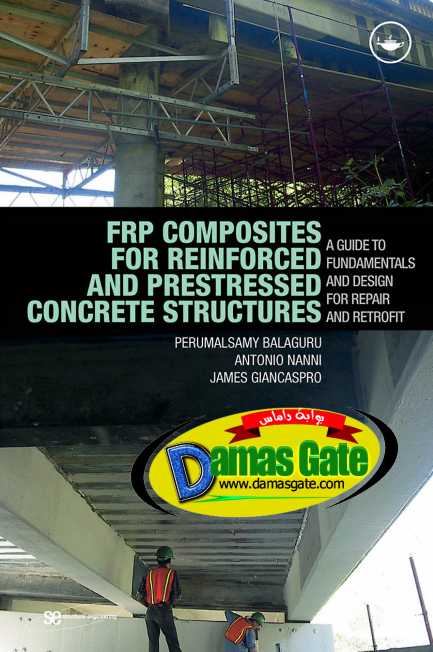FRP Composites for Reinforced and Prestressed Concrete Structures

Preface
Fiber-reinforced polymer (FRP) is a common term used by the civil engineering community for high-strength composites. Composites have been used by the space and aerospace communities for over six decades and the use of composites by the civil engineering community spans about three decades. In the composite system, the strength and the stiffness are primarily derived from fibers, and the matrix binds the fibers together to form structural and nonstructural components. Composites are known for their high specific strength, high stiffness, and corrosion resistance. Repair and retrofit are still the predominant areas where FRPs are used in the civil engineering community. The field is relatively young and, therefore, there is considerable ongoing research in this area. American Concrete Institute Technical Committee 440 documents are excellent sources for the latest information.
The primary purpose of this book is to introduce the reader to the basic concepts of repairing and retrofitting reinforced and prestressed concrete structural elements using FRP. Basic material properties, fabrication techniques, design concepts for strengthening in bending, shear, and confinement, and field evaluation techniques are presented. The book is geared toward advanced undergraduate and graduate students, professional engineers, field engineers, and user agencies such as various departments of transportation. A number of flowcharts and design examples are provided to facilitate easy and thorough understanding. Since this is a very active research field, some of the latest techniques such as near-surface mounting (NSM) techniques are not covered in this book. Rather, the aim is to provide the fundamentals and basic information.
The chapters in the book are arranged using the sequences followed in textbooks on reinforced concrete. Chapter 1 provides the introduction, brief state of history, typical field applications, and references to obtain the latest information. In Chapter 2, the properties of common types and forms of fiber reinforcement materials and resins are presented. Brief descriptions of the four basic types of hybrids are also discussed. Chapter 3 deals with the methods to prepare laminate samples, including resin mixing, hand lay-up technique, vacuum bagging, curing methods, density determination, and laminate cutting.
Chapter 4 provides the basic information on the properties of fibers and matrices used for the composite, behavior of beams and columns strengthened with the composites, design philosophies, and recent advances. The most popular uses are for (i) strengthening of reinforced and prestressed concrete beams for flexure, (ii) shear strengthening of reinforced and prestressed concrete beams, (iii) column wrapping to improve the ductility for earthquake-type loading, (iv) strengthening of unreinforced masonry walls for inplane
and out-of-plane loading, (v) strengthening for improved blast
resistance, and (vi) repair of chimney or similar one-of-a-kind structures.
Download
http://s18.alxa.net/s18/srvs2/01/FRP...Structures.rar

Preface
Fiber-reinforced polymer (FRP) is a common term used by the civil engineering community for high-strength composites. Composites have been used by the space and aerospace communities for over six decades and the use of composites by the civil engineering community spans about three decades. In the composite system, the strength and the stiffness are primarily derived from fibers, and the matrix binds the fibers together to form structural and nonstructural components. Composites are known for their high specific strength, high stiffness, and corrosion resistance. Repair and retrofit are still the predominant areas where FRPs are used in the civil engineering community. The field is relatively young and, therefore, there is considerable ongoing research in this area. American Concrete Institute Technical Committee 440 documents are excellent sources for the latest information.
The primary purpose of this book is to introduce the reader to the basic concepts of repairing and retrofitting reinforced and prestressed concrete structural elements using FRP. Basic material properties, fabrication techniques, design concepts for strengthening in bending, shear, and confinement, and field evaluation techniques are presented. The book is geared toward advanced undergraduate and graduate students, professional engineers, field engineers, and user agencies such as various departments of transportation. A number of flowcharts and design examples are provided to facilitate easy and thorough understanding. Since this is a very active research field, some of the latest techniques such as near-surface mounting (NSM) techniques are not covered in this book. Rather, the aim is to provide the fundamentals and basic information.
The chapters in the book are arranged using the sequences followed in textbooks on reinforced concrete. Chapter 1 provides the introduction, brief state of history, typical field applications, and references to obtain the latest information. In Chapter 2, the properties of common types and forms of fiber reinforcement materials and resins are presented. Brief descriptions of the four basic types of hybrids are also discussed. Chapter 3 deals with the methods to prepare laminate samples, including resin mixing, hand lay-up technique, vacuum bagging, curing methods, density determination, and laminate cutting.
Chapter 4 provides the basic information on the properties of fibers and matrices used for the composite, behavior of beams and columns strengthened with the composites, design philosophies, and recent advances. The most popular uses are for (i) strengthening of reinforced and prestressed concrete beams for flexure, (ii) shear strengthening of reinforced and prestressed concrete beams, (iii) column wrapping to improve the ductility for earthquake-type loading, (iv) strengthening of unreinforced masonry walls for inplane
and out-of-plane loading, (v) strengthening for improved blast
resistance, and (vi) repair of chimney or similar one-of-a-kind structures.
Download
http://s18.alxa.net/s18/srvs2/01/FRP...Structures.rar